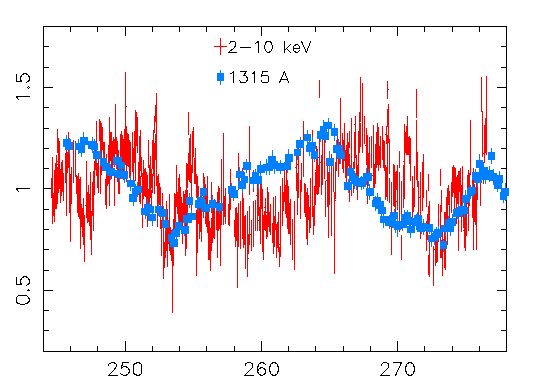NGC 7469

(Credit: Figure and Text courtesy of Paul Nandra.)
A near-continuous monitoring campaign of the Seyfert 1 galaxy NGC 7469 was
undertaken in the X-ray with RXTE, investigating time scales from hours to one
month. Simultaneous monitoring was performed in the UV with IUE, making this
the most intensive X-ray/UV variability study performed for an active galaxy.
The UV and X-ray light curves show amplitude variations of similar magnitude,
but are not strongly correlated at zero lag time. While the maxima in the UV light
curve appear to precede those in the X-ray by ~4 d, the minima of the light
curves are near-simultaneous. This implies that models of the continuum
emission of AGN which invoke simple UV re-radiation of X-ray photons, as well
as models in which the X-ray are produced solely by Compton upscattering of
UV radiation, must be revised. Two variability mechanisms which have no simple
relationship are required to explain the observed UV/X-ray variability.
The X-ray light curve (RXTE PCA, 2-10 keV) binned at 512 s time resolution (red)
together with the IUE 1315 Angstrom light curve in the UV (blue, Wanders, 1997). Both
light curves have been normalized to their mean value and are plotted on the same time
axis. We note the remarkable similarity in the amplitudes of variability on long time scales,
but clear evidence for more rapid X-ray variations which are not observed in the UV.
The light curves are not well correlated at zero lag, but the two prominent troughs appear
to line up rather well in the time domain. In contrast, the apparent peaks in the UV light
curve appear to precede the X-ray peaks.
Click here for the
gif version
|
|
Additions or Comments:
Have we left anything out? Is there something you would like to have added
to this page (a link to your own group's research page, for example...)?
|
IMAGES |
By Mission |
Stars |
Cataclysmic Variables |
X-ray Binaries |
Pulsars |
Supernova Remnants & Planetary Nebulae |
Galaxies |
Active Galactic Nuclei |
Clusters and Groups of Galaxies |
X-ray/gamma-ray Background & Deep Fields |
Solar System Objects |
Gamma Ray Bursts
HEASARC Home |
Observatories |
Archive |
Calibration |
Software |
Tools |
Students/Teachers/Public
Last modified: Thursday, 26-Jun-2003 13:48:46 EDT
|


